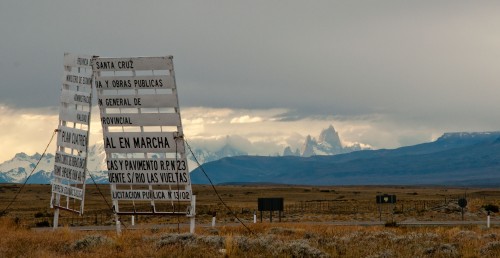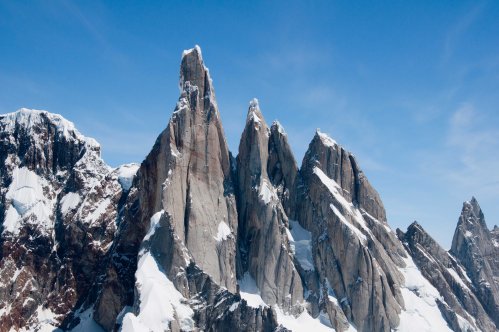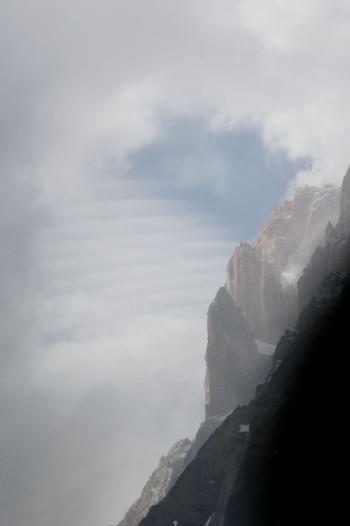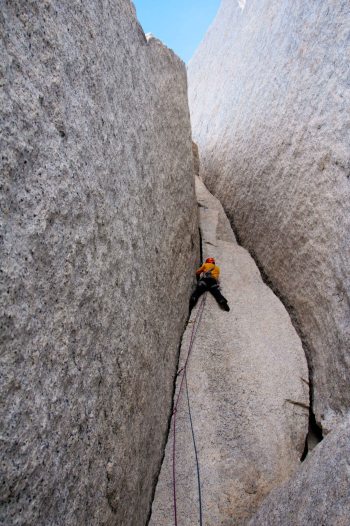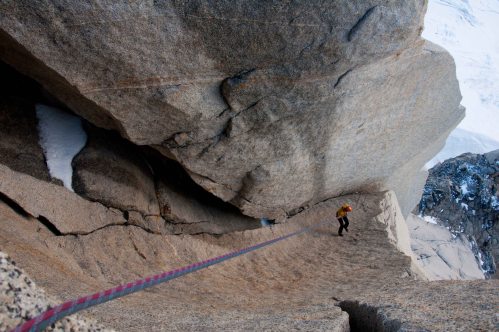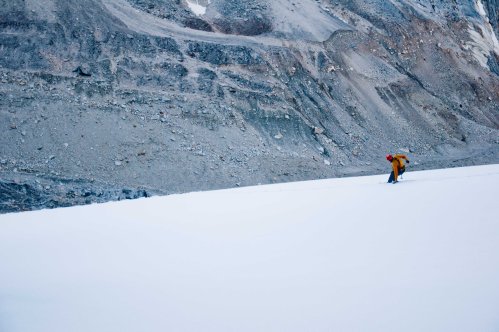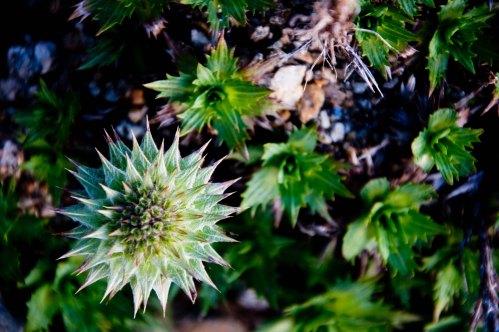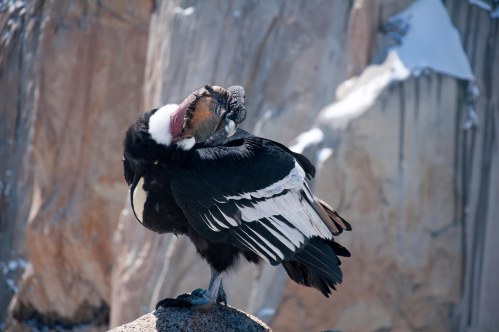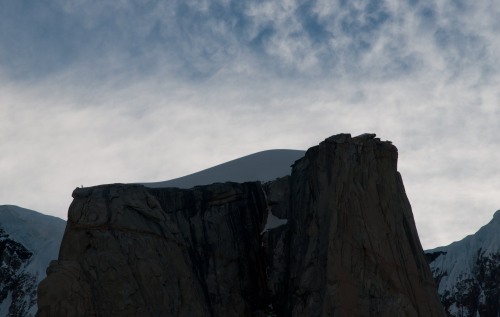We knew little about El Chaltén before getting there except that it is a small touristic town at the foothill of Cerro Fitz Roy and that it would be the starting point of our climbs on the nearby granit spires. Some months ago in Huanchaco (Peru) during our surfing break we had watched a climbing movie taking place in El Chaltén. An American climber accompanied by two friends honoured the memory of his deceased girlfriend by opening a new route in the Fitz Roy range. Their plans were thwarted by persisting bad weather until they could realize a first ascent in the very last days of their trip. Some sequences of the movie endeavored to show the town and the climbers trapped by the storm: rain drops splashing against the windows of small, neat, wooden houses standing bravely in the high wind. My mind had shaped a picture of El Chaltén similar to the one of Hogsmeade, the small town next Harry Potter’s wizardry school (it is funny how imagination works…). Low houses overwhelmed by succeeding cold fronts or by the spirit of Voldemort and painted with bright colours as an act of defiance against the harsh climate or against dark magic. Grocery, bakery, coffee shop, hostal lined up along the main street and proposing services and goods to the visitor at the same time as they provide him with a temporary shelter. Our arrival in El Chaltén from Esquel along “Ruta 40” meant the expiry of my mental projection and its replacement with a more positive one.
The rapid development of the town in the last years under the pressure of the tourists flow took place in a quite spontaneous way. Its grid pattern of streets stretches out in all directions and the transition from pavement to gravel indicates the distance to the center. The mixed construction styles are only dictated by the taste and the often modest resources of the owners. As a result El Chaltén reminds of any functional town in remote areas of Canada or Scandinavia. The 100 m high cliffs surrounding the town in the south-east could even mislead the uninformed visitor by making him think that he finds himself in a rock quarry.
Ten years ago El Chaltén was confined to one camping and one grocery. Climbers did not stay in town between two “brechas” (or good weather windows) but used to camp closer to the peaks at places like D’Agostini, Rio Blanco or Rio Eléctrico about two hours away from El Chaltén. Nowadays El Chaltén counts dozens of hostals, restaurants and shops. Phone and internet connections are available (satellite connections though, slow and dependent on weather and winds) and all climbers return to town after a “brecha”.
In the winter El Chaltén leaps ten years into the past. It is deserted by most of its inhabitants/seasonal workers (the population not including tourists reduces from 5’000 to less than 500) and the economic activity of the town stops except for some construction work. First inhabitants came from the region around El Calafate 200 km away (which has also experienced an important development in the last years because of tourism). In the mid 90’s, during the economical crisis that struck Argentina, many people facing unemployement moved to touristic regions offering better job opportunities from all over the country .
On our first day in El Chaltén we raced around town to get information about accomodation (the hostal booked in advance per internet was crap), weather forecasting, route conditions and topos. We got a copy of the sport climbing topo for El Chaltén at Kalen restaurant. It is also Maria, its young boss and best cook in town, who gave us the adress of Refugio Chaltén or “La casa de Jesús”, the fantastic hostal where we would stay during our time in town. In the late afternoon, on the advice of a climber met in the street we ended up at Aires Patagónicos, a restaurant organizing private sales of mountain equipment and having the freshly printed alpine climbing topo by Rolando Garibotti (also founder of the very useful website PATAclimb.com) for consultation. Climbers progressively showed up in the restaurant and we rapidly found out that a two days “brecha” had just come to an end the day before. We learnt pretty much everything what we needed to know thanks to Belgian climbers and Juan, climber and cook at Aires Patagonico: how to generate the correct GFS meteogram, how to recognise a “brecha”, how to access the Niponino base camp, how to watch out for the hungry fox, … Another two days “brecha” was forecasted four days later and we planned to rock climb around Niponino on the not too high Agujas Media Luna or Mocho. It had been snowing a lot in December and there was still much snow in the cracks and ledges of the higher peaks. We also decided to make a roundtrip to Niponino before the “brecha” to scout the path and the rock faces and to carry equipment in advance. The models were forecasting winds up to 10 knots for the next day and up to 13 knots for the day after next. We had been told that no one climbs with 10 knots of wind but we did not think of 10 knots to be an issue to hike.
We walked 2.5 hours to Laguna Torre one of the most popular hikes around El Chaltén not noticing much wind thanks to the forests and morains lining the trail. At the lake we put on our harnests to cross the river over the tirolean and skirted the lake heading to the Torre glacier. The wind picked up as we left forested terrain. We lost our way on the descent to the glacier, scrambling down loose morains and thrown off by powerful wind gusts and by our heavy backpacks. Back on the footpath along the glacier the wind was so high that we often stopped and held on to the rocks not to be knocked down. At the time of stepping onto the glacier (still 1.5 hours away from Niponino, El Chaltén-Niponino takes 6 hours), arched over our walking poles, stunned by the power of the wind, wearing gore-tex and gloves and hat despite the warm air and very worried about our tent going through the night, we resolved to stash our equipment on the spot and to return to El Chaltén. It was our first face-to-face with the Patagonian wind and that afternoon we promessed ourselves not to underestimate it in the future.
The day before the “brecha” the wind had been replaced by a light rain. We left El Chaltén at 12 am, accompanied by “deux lucioles” until Laguna Torre. The more we were progressing into the valley the heavier the rain was becoming. We again lost our way on the glacier and arrived at Niponino at 7 pm. During the night the rain ceased and on the next morning the sky was blue and the air was still. We climbed “Rubia y Azul” on Aguja Media Luna, one beautiful (free climbing) route (there are not so many in comparison with aid climbing routes, which you are welcome to free by the way…). The lower pitches were wet and the top pitch icy and we had a party in front of us and the El Chaltén grades are what they are (read next post) and we are anyway pussies so that we turned back at Niponino at 11 pm quite exhausted (14 hours after having left). On the second day of the “brecha” we opted for more approach and less demanding climbing with the route “Austríaca” on Aguja de l’S. That second day was more relaxing and the next morning the wind was picking up again. At 9 am we left Niponino enjoying amazingly light backpacks (most of our gear hidden below 100 kg of rock to discourage “el zorro”, the fox). We would be back “cuando vendra la proxima brecha…”
During that “brecha” two accidents happened. One instable boulder rolled over a climber approaching the Noruego camp and broke her coccyx whereas another climber broke his ankle sliding on the snow with his crampons on… In both cases a “rescate” or rescue was organized by the rangers of the national park with no other means than a stretcher and volunteers among the climbers (the closest helicopter is in El Calafate). In both cases it took around ten hours to carry the injured climber to El Chaltén and around 30 persons in total to take turns (the time between the accident and transport is not included).
We climbed:
– Aguja Media Luna, “Rubia y Azul”, 350m, 6c
– Aguja de l’S, “Austríaca”, 180m, 6a
More pictures can be found here.


